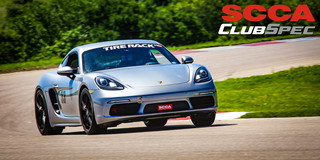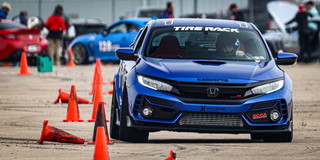
The following article was originally published in the January, 1984 edition of SportsCar Magazine, written by James T. Crow, former editor of Road & Track. The photo captures the start of a Runoffs race at the second Runoffs in Daytona, FL.
The Way We Were: A Look back at the first ARRC
It was 19 years ago that it all began. The dates were November 12-15, 1964. The place was Riverside International Raceway in Southern California and the weather was cold with occasional sand storms.
The event was the first of what now became an SCCA tradition: The American Road Race of Champions. Now known as the Champion Spark Plug Road Racing Classic. Which, no matter the formal name, has always been better known simply as The Runoffs.
Obviously, it was an idea whose time had come. A genuine high-noon shootout in the 17 club racing classes of the day. Everything from A to H Production (427 Cobras to 948cc Sprites) and C through H Modified (unlimited displacement down to 750cc max), plus Formula Vee, Junior and Libre.
For those of you who were around in those days, let me remind you who the club officials were. Ray Altman of the San Francisco Region was the club’s chairman. The executive director was John Bishop—yes, the same John Bishop whose name is now synonymous with IMSA. Jim Kaser was competition director and Dic Van der Feen (also now with IMSA) the public relations director.
After 19 years it’s difficult to remember a time when there weren’t any Runoffs. Before that first ARRC, the National Champion in each class was the driver in each class who finished the season with the greatest number of points won in races that carried an SCCA National Race sanction.
In theory, every driver had an equal opportunity to win a championship, but geography mitigated against that. As a result, most of the National Champions were from the northeast, where the largest number of National races were most easily accessible. As a result, almost no driver from the west could afford the time or money it would take to win a National Championship.
So the idea was to hold The Runoffs. The basic agitator was the legendary Tracy Bird from Tucson. The crusty Mr. Bird had been growling about the inequities of the system and trying to stir up interest in a World Series for club racing ever since 1958.
Eventually, Tracy was instrumental in getting a series of five Divisional Championships organized and the National Championships retreated even farther into the east. In 1963 the Eastern Tennessee Region proposed an interdivisional championship much like the racing tournament Bird had envisioned and Ray Altman, the club’s chairman, kept pushing until it happened. The old National Championship program was abandoned with the running of the first ARRC in 1964, but it wasn’t until 1966 that ARRC winners were actually given the title of National Champion.
So, the program, as organized in 1964, was a series of races during the regular season that would result in Divisional Champions. And the 1-2-3 finishers in each class would be invited to The Runoffs to see who was really the best.
There were six SCCA Divisions at that time and $4 from the entry fee for each of the qualifying races went into a kitty to help defray travel expenses. A motel room was also supplied as part of the fringe benefits and there was some kind of party or dinner every night that was also included with the invitation. Then (as now) there were some impecunious drivers who had little other resources to sustain them when they arrived in Riverside for the biggest race of their lives.
What were the cars like in those dim, dark, historic days? Well, my children, the main difference was that production racing cars still looked like cars. No modifications to the bodywork were allowed, tires had to fit underneath the original fenders and about the only aerodynamic device permitted, if you could call it that, was a tonneau cover over the passenger’s seat.
Rollbars were required, but MGBs still looked like MGBs, TR4s like TR4s, Sprites like Sprites and Jaguar XKEs even looked like XKEs. We didn’t know how lucky we were.
The production class winners, just to give you an idea what was running in those days, were 427 Cobra (AP), Jaguar E-type (BP), Morgan SS (CP), Triumph TR4 (DP), Porsche Speedster (EP), Volvo P1800 (FP), Triumph Spitfire (GP), and Austin-Healey Sprite (HP).
In the modified car classes, some of the marques you might remember included Elva, Osca, Merlyn, DB, Bandini, Genie, Bobsy, Cooper, Dolphin and Cheetah. There were also Specials bearing names like Cro-Sal, Shivley-Clem, Townsend, Meyer, Webster and Pink Elephant.
Of the 306 drivers who were eligible for The Runoffs, a total of 183 actually started during the finals. As expected, the Pacific Coast Division had the largest number of entrants (50), but every Division was represented and enthusiasm among the participants was high.
Were there big names in the races? Well, there weren’t any Stirling Mosses or Parnelli Joneses, but there were some drivers whose names still appear in the Runoffs roster year after year. Like Jerry Hansen (Formula Vee and a CM that went by the name of Chevette), Bob Sharp (in the only Datsun entered that year) and Bob Tullius (TR4). There was even a token female driver, Prudence Baxter, from the Pacific Division. And of course there was A. M. “Oscar” Kovaleski, one of the enduring legends of the series.
What kind of success was the first ARRC? Financially, none at all, I’m afraid. The weather was cold, windy and unpleasant in the way that Riverside can be in November and the fans that did come to watch were more conspicuous for their endurance than their enthusiasm.
Nor was there a lot of sensational racing, it’s strange to report. In only four of the 17 classes were third-in-class cars any closer than a minute behind the winners, and it was only in Formula Vee that the sixth place driver found himself unlapped at the end of the 45-minute race.
But never mind that. For most of the drivers, it was the greatest weekend of their racing lives.
The original dream called for The Runoffs to be hosted by a different division every year, each one taking its turn. That never happened either. That first year it was Riverside that bought the dream, and through 1969 the ARRC alternated between Riverside and Daytona. In was no greater success at Daytona than at Riverside, however, and it wasn’t until it moved to Atlanta in 1970 that it finally found a home.
To round out the historical perspective and give credit where it is due, the first ARRC was sponsored by Riverside International Raceway and Sports Car Graphic magazine. The race committee consisted of Les Richter (Riverside Raceway), Robert E. Petersen (Petersen Publishing), John Christy (editor, Sports Car Graphic), Chic Vandagriff (Cal Club Region chairman) and John Bishop (SCCA executive director).
And the class winners in that historic event were: AP—Ed Leslie, Cobra; BP—Merle Brennan, Jaguar XKE; CP—Earl Jones, Morgan SS; DP—Bob Tullius, TR4; EP—Alan Johnson, Porsche; FP—Dick Hill, Volvo P1800; GP—Ed Barker, Spitfire; HP—Fred Salo, Sprite; FVee—Lew Kerr, Formcar; FJr—Ron Herrera, Lotus; FL—George Alderman, Cooper; CM—Part Martin, Cooper-Chev; DM—Jerry Titus, Webster Spl; EM—Ralph Wood, Elva-Porsche; FM—Rick Muther, Lotus 23B; GM—Charles Barns, Marlyn; HM—Dan Parkinson, Dolphin.
Ave atque vale, you guys. You started a great tradition.










